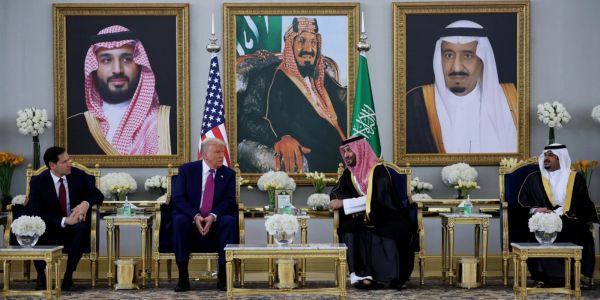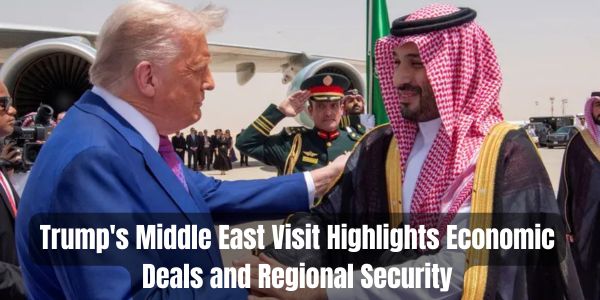RIYADH, Saudi Arabia – U.S. President Donald Trump embarked on a high-stakes tour of the Middle East, landing in Saudi Arabia on May 13 for the first leg of a four-day trip that also includes stops in Qatar and the United Arab Emirates (UAE). The visit, Trump’s first major overseas trip since his reelection, underscores his administration’s focus on securing economic investments and addressing regional security challenges, while a colorful speech in Riyadh drew global attention.
A Lavish Welcome and Major Economic Wins
Trump was greeted with a lavish reception at King Khalid International Airport in Riyadh, where he met with Saudi Crown Prince Mohammed bin Salman. The centerpiece of the visit was a historic $600 billion investment commitment from Saudi Arabia into the U.S. economy, alongside a $142 billion arms deal described by the White House as the largest defense cooperation agreement in U.S. history. The agreements, signed during a ceremony at the Royal Palace, cover energy, defense, mining, and technology sectors.
“A great day in Saudi Arabia!!!” Trump posted on Truth Social, celebrating the economic deals that he claims will create “tremendous” job opportunities in the U.S.
The economic focus continued as Trump attended the 2025 Saudi-U.S. Investment Forum, joined by American business leaders like Tesla’s Elon Musk and BlackRock’s Larry Fink. Saudi Arabia’s pledge aligns with its Vision 2030 plan to diversify its economy, while the UAE has committed $1.4 trillion over the next decade to U.S. sectors like AI and semiconductors. Qatar, hosting the largest U.S. military base in the region, is expected to discuss further investments during Trump’s visit to Doha.
Must Read: Anita Anand Appointed Canada’s New Foreign Minister in Major Cabinet Reshuffle

An Unconventional Speech Steals the Spotlight
During a speech at the investment forum, Trump made headlines with an eclectic mix of boasts and proposals that captivated the audience. He touted domestic achievements, including border security, and announced a surprising decision to lift U.S. sanctions on Syria, imposed under the Caesar Act, to support the country’s reconstruction under its new president, Ahmed al-Sharaa. “We’re giving Syria a chance at greatness,” Trump declared, earning a standing ovation.
Trump also stirred controversy by proposing to rename the Gulf of Mexico as the “Gulf of America,” a remark that drew chuckles from Saudi dignitaries. Even more eyebrow-raising was his suggestion to rebrand the Persian Gulf as the “Arabian Gulf” or “Gulf of Arabia,” a move that could inflame tensions with Iran at a delicate time in nuclear negotiations. As the audience stood for Lee Greenwood’s “God Bless the USA,” Saudi leaders filmed the swaying president, marking a surreal moment in the conservative kingdom.
Regional Security and Geopolitical Maneuvering
Beyond economics, Trump’s agenda includes pressing security concerns. In Riyadh, he urged Iran to pursue a “new and better path” for a nuclear deal, warning of “massive maximum pressure” if Tehran refuses. Gulf leaders, wary of escalation, are expected to seek clarity on the U.S. approach to Iran and assurances against unilateral Israeli actions in the region.
In Qatar, Trump will meet Emir Sheikh Tamim bin Hamad Al Thani to discuss military cooperation and Doha’s mediation efforts in Gaza ceasefire talks. The UAE stop in Abu Dhabi will focus on deepening strategic ties with President Mohammed bin Zayed, particularly in AI and defense. Notably, Trump’s itinerary excludes Israel, a decision attributed to ongoing tensions in Gaza and strained relations with Prime Minister Benjamin Netanyahu.
“Nothing good can come out of a visit to Israel at the moment,” a U.S. official told Axios, reflecting the administration’s pivot toward Gulf allies.
Controversies and Conflicts of Interest
The trip has not been without criticism. The Trump Organization’s expanding real estate ventures in Saudi Arabia, Qatar, and the UAE—including a Trump Tower in Riyadh and a golf resort in Doha—have raised concerns about potential conflicts of interest. Critics, including watchdog groups, argue that Trump’s business ties could influence U.S. foreign policy, especially as his sons, Donald Jr. and Eric, actively promote these projects in the region.
Additionally, Trump’s acceptance of a Boeing 747-8 “gifted” by Qatar for use as a new Air Force One has sparked ethical debates. Defending the move, Trump called the current Air Force One “small” and “less impressive” than Middle Eastern leaders’ aircraft, dismissing concerns in a Fox News interview.
Must Read: Trump’s Qatar Jet Controversy: $400M Gift Divides GOP, Raises Security Fears
A Transactional Vision for the Middle East
Trump’s Gulf tour reflects his transactional approach to foreign policy, prioritizing deals over traditional diplomacy. While he expressed hope for Saudi Arabia to join the Abraham Accords, Crown Prince Mohammed bin Salman signaled that normalization with Israel remains unlikely without progress on Palestinian statehood. The Gaza conflict, coupled with regional fears of a broader war involving Iran, looms large over the visit.
As Trump moves to Qatar and the UAE, the world watches whether his deal-making flair can deliver on economic promises while navigating the Middle East’s complex security landscape. For now, his Riyadh speech—equal parts showmanship and policy—has set the tone for a trip that blends business, bravado, and geopolitics.

